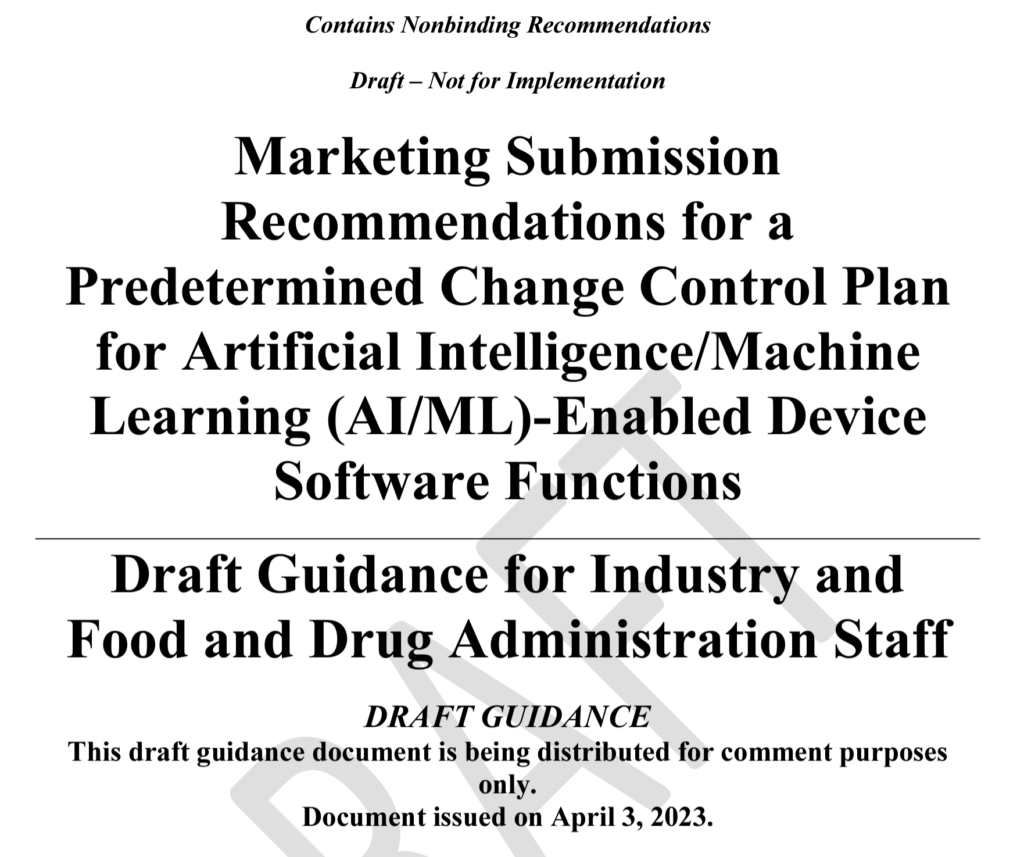Artificial Intelligence and Machine Learning Medical Devices
The FDA released a new draft guidance document about artificial intelligence and machine learning (AI/ML) functions in medical devices.
What is a predetermined change control plan for artificial intelligence (AI) software?
The new FDA guidance is specific to predetermined change control plans for marketing submissions. The guidance was released on March 30, 2023, but the document is dated April 3, 2023. The draft guidance applies to artificial intelligence (AI) or Machine Learning-Enabled Device Software Functions (ML-DSF), including modifications automatically implemented by the software and modifications to the models implemented manually.

A PCCP must be authorized through 510k, De Novo, or PMA pathways, as appropriate. The purpose of including a PCCP in a marketing submission is to seek premarket authorization for these intended device modifications without necessitating additional marketing submissions for each change described in the PCCP.
How do you determine if a 510k is required for a device modification, and how would a PCCP affect this?
Currently, there are three guidance documents relating to the evaluation of changes and determination if a new premarket submission is required:
- Deciding When to Submit a 510k for a Software Change to an Existing Device
- Deciding When to Submit a 510k for a Change to an Existing Device
- Modifications to Devices Subject to Premarket Approval (PMA) – The PMA Supplement Decision-Making Process
These guidance documents will still be the first steps in evaluating changes. Only changes specific to artificial intelligence (AI) or ML-DSF that would result in a new pre-market submission could be subject to a PCCP.
Examples of Employing AI/ML-DSF PCCPs
- Retraining a model with more data to improve device performance while maintaining or increasing sensitivity. If this type of change is pre-approved in the PCCP, the labeling can be updated to reflect the improved performance once the change has been implemented.
- Extending the scope of compatible hardware with a device system. For example, if the algorithm was initially trained using one specific camera, ultrasound, defined parameter, etc., then a PCCP could add additional cameras/ultrasounds/modified parameters.
- Retraining a model to optimize site-specific performance for a specific subset of patients with a particular condition for whom sufficient data was unavailable. The PCCP could expand the indications once such data were available.
What is the difference between a locked vs. adaptive algorithm?
A locked algorithm is a software function involving human input, action, review, and/or decision-making before implementation. Once the algorithm is designed and implemented, it cannot be changed without modifying the source code.
Locked algorithms contrast with adaptive/automatic algorithms, where the software will implement changes without human intervention. The adaptive/automatic algorithms are designed to adjust according to changing input conditions. The adaptive/automatic algorithm is designed to recognize patterns in the input data and adjust its processing accordingly.
Typically locked algorithms apply to fixed functions such as a decision tree, static look-up table, or complex classifier. For AI/ML-DSF, manually implemented algorithms may involve training the algorithm on a new dataset or serving a new function. Once the training is complete, the algorithm will be implemented into the software. Adaptive algorithms are programmed such that their behavior changes over time as it is run based on the information it processes.
As it relates to a PCCP, the detailed description of the intended modifications needs to specify which algorithm type is being modified.
What is included in a PCCP for artificial intelligence (AI) software?
A PCCP should consist of:
- Detailed Description of Intended Modifications
- Modification Protocol describing the verification and validation activities, including pre-defined acceptance criteria
- Impact Assessment identifying the benefits and risks introduced by the changes
The detailed description of the intended modifications should list each proposed device modification and the rationale for each change. If changes require labeling modifications, that should also be described. It should also be clearly stated whether or not the proposed change is intended to be implemented automatically or manually. The description should describe whether the change will be implemented globally across all devices on the market or locally, specific to different devices based on the unique characteristics of the device’s patient or clinical site.
The types of modifications that are appropriate for a PCCP include modifications related to quantitative measurements of ML-DSF performance specifications, changes related to device inputs, and limited modifications relating to the device’s use and performance. The draft guidance provides some examples of each of those modification types.
The content of the modification protocol section requires a description of planned data management practices relating to the reference standard and annotation process, a description of re-training practices and processing steps, performance evaluation methods and acceptance criteria, and internal procedures for implementing updates.
The impact assessment is the documentation of the evaluation of the benefits and risks of implementing the PCCP for the software. Any controls or mitigations of the risks should be described in this section.
Appendix A of the draft guidance includes example elements of modification protocol components for ML-DSFs. Appendix B includes examples of ML-DSF scenarios employing PCCPs.
If, at some point, the manufacturer wants to make changes to the content of the PCCP relating to either the modifications described or the methods used to validate those changes, that generally would require a new marketing submission for the device.
Utilizing a PCCP in your QMS Change Control System
When evaluating and implementing changes, the manufacturer shall do so in accordance with their Quality Management System change control processes. This should require a review of planned modifications against the FDA guidance documents for evaluating changes and the PCCP. For the change to be acceptable under the PCCP, it must be specified in the Description of Modifications and implemented in conformance with the methods and specifications described in the Modification Protocol. A new premarket submission is required if it does not meet those requirements.
Artificial Intelligence and Machine Learning Medical Devices Read More »
